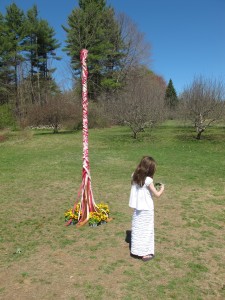May Day is my favorite Pagan holiday. I first learned of it when I was a teenager. My best friend, Robin, and I would spend the week before making May baskets out of woven pieces of colorful construction paper, filling them with crepe paper “straw” (not plastic in those days) and baking goodies which we put into the baskets – peanut brittle, brownies, snicker doodles and candy. On April 30, Robin would sleep over at my house. We would finish our baskets, then map out our route. Before school early the next morning, we would walk through the neighborhood leaving a basket on each doorstep of kids for whom we babysat. If they were up, we would ring the bell and run around the corner so they wouldn’t see who left it.
In college, I spent my junior year abroad in Oxford, England, where May Day, I learned to my delight, was a major holiday. My friend, Kit, and I dressed gaily and went out at dawn to join the throngs of people welcoming in the spring, or sumer, as it was called. There were Morris dancers on every corner, fiddlers and concertina players everywhere, people dancing in the streets. At the end of the day, a huge bonfire was lit to signal the start of sumer.
The ancient roots of May Day, or Beltane, as it was originally known, can be traced back as far as Roman times. Celebrated in Northern Europe, May Day was acknowledged as the first day of summer, a joyful celebration of the end of winter’s hold on the earth and the beginning of the growing season; seeds, crops, animals, creativity and life. The May Pole, a fresh tree of oak, elm or birch, was brought from the forest each May and placed in the town square as a visible symbol of new growth. Decorated with flowers and colored ribbons, the May Pole and its dance enacted the joyful return of spring, the release of the earth’s creative energies and the human connection to this “tree of life,” linking heaven and earth.
When my children were old enough for school, they went to Canterbury Children’s Center, a large, one-room school house with sheep, chickens, burros and a May Pole. I became the music teacher. On May Day, the teachers and adults all wore white. At school, we made eucalyptus garlands for everyone from the large eucalyptus tree in the greenhouse. We san songs celebrating May Day –
~ “As I mee walkéd in a May morning, I heard a bird sing – cuckoo!”
~ “Sumer is a comin’ in, loudly sing cuckoo!”
~ “Unite and unite, now let us unite for sumer is a come in today
And whither we are going we all will unite in the merry morning of May.”
Dudley and Jacqueline Laufman came every year to play their fiddles and the squeezebox, as Dudley called it, which was a concertina. They sang songs and told tales of May Day in England long ago, of St. George and the Dragon and the return of spring. When it came time for the May Pole, the fiddles called us to the dance. The children wove their ribbons in and out, in and out, round and round, all the while singing, “Unite and unite, now let us unite,” until the ribbons became too short. The colorful weaving down the pole reminded us all that we were one connected community from the CCC to the world.
After the May Pole, we all returned in to the school for some country dances, led by Dudley and Jacqueline. They always began and ended the day with a poem and song Dudley wrote, called “The Sweets of May.” The last verses leave us with hope for next year, knowing how the seasons circle around and around, just like the May Pole dance itself.
June and then July,
Autumn and longy winter,
All the seasons die.
O how I miss the springtime
And the May again
When the men dance around the ladies
And the ladies go round the men.”
This May Day, go pick some daffodils. Put them in your hair or in a vase. Give some to a friend. Sing a song to welcome this luscious season. Don’t worry if you don’t know one. Make it up. May your light be strong and you spirit free as we expand and soar through the long, warm days ahead.



Speak Your Mind